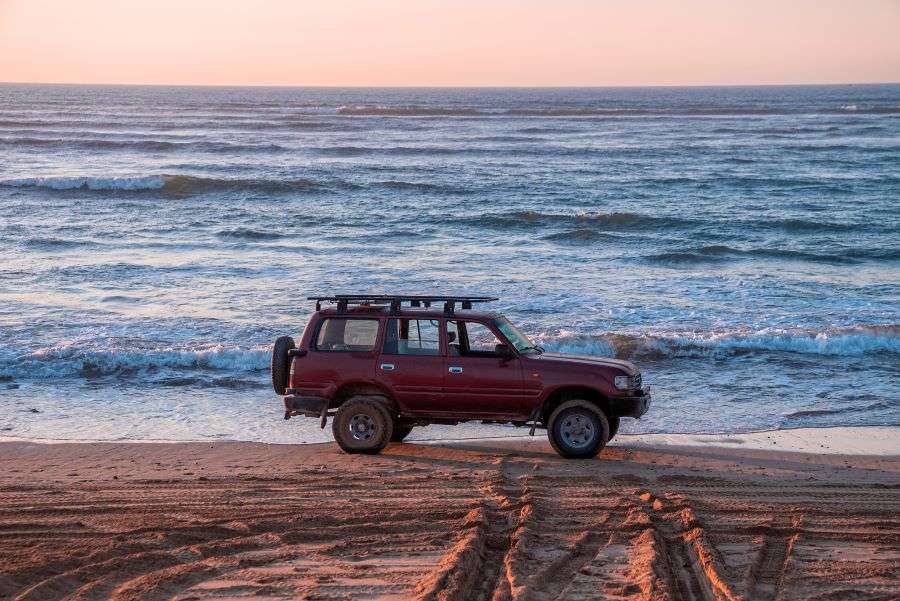Last Updated on March 3, 2023 by Paul S.
Heading to the beach this summer and planning on driving in the sand? This article will provide the best tire pressure to set your tires to once you have reached where the pavement ends, and the sand begins! Not a lot can beat driving on the sand with the ocean waves crashing but having the confidence that you can do it helps you enjoy it even more.
Table of Contents
What Is The Best Tire Pressure For Driving On The Beach?
Typically, the lowest tire pressure you can safely ride on the beach is 20 psi but please note this can vary from vehicle to vehicle. There is potential to lower it even more, but you can run the risk of rolling the tire off the rim, and that can put you in a bad situation as it will be difficult to jack up the vehicle in the sand.
How Does Lowering The Tire Pressure Help In Beach Driving?
Lowering the tire pressure allows for more surface area of the tire to come in contact with the sand. This provides more traction for your tire and distributes the weight of your vehicle so it’s not concentrated on one point.

How to drive on the Beach?
Here are some important tips for driving on the beach:
- It is best to have a 4wd or awd vehicle. In some cases it will not matter but the best way to check if you can get away with a 2wd vehicle is see if others are doing it.
- Let the air out of your tires down to 20 psi. You can take the air out of your tires using the cap, air gauge, or a screwdriver but you will have to apply pressure to the pin at the center of the tire valve.
- With your air pressure lowered understand that you cannot drive at the same speeds as when you had the recommended air pressure. Nor can you turn as aggressively as this could cause the tire to come off the rim.
- If you do get stuck and you can try the following to get out of the rut.
- Apply pressure to the gas peddle slowly.
- Keep the tires straight and not turned.
- You can try to rock it out of the hole you are in.
- Do not get frustrated and spin the tires this will only make it worse.
- If there is a noticeable pile of sand that your undercarriage could get stuck on avoid it.
- If there is a small soft spot of sand check to see how deep it is. If it’s not too deep hit it with some speed and maintain that speed to get through it otherwise head back the way you came.
- If you have the capability put it in 4 low to get through deep sandy sections.
- Get help!
- Check out the gear list below.
- Understand the tides. Let’s keep your vehicle out of the water! Check this great website for tides: https://www.tide-forecast.com/
In my excursions out on the sand I haven’t had too many problems running my tires with regular pressure. This of course depends on the beach and the type of sand, water level, and your experience level of driving.
I did get stuck once when I was driving our Mitsubishi Delica on the North Island of New Zealand. The vehicle was a 4×4, but the sand was a little too deep causing us to get stuck for around 20 minutes. After trying to get out by just driving we simply let some air out of our tires and got back to the pavement before the tide rose up! Now at the time, I didn’t have a tire gauge in the vehicle, bad move, but I only let out a little bit of air to gain some traction in the sand.
Gear List For Beach Driving
- Tire Gauge
- Portable Tire Inflator
- Tow Strap
- Traction Mats
- Shovel
Conclusion
Your adventure in the sand is going to be amazing but having a little knowledge of driving in the sand will help if you hit any soft spots along the way. 20 PSI for your tires is recommended and be cautious about lowering it any more than that so you don’t get stuck because of user error.
Remember driving slower is better until you have the hang of it. If you have any experience driving in the snow in terms of getting stuck, then you are ahead of the game! Have fun out there!
Check out our article about off road tire tread patterns!
Off Road Tire Tread Patterns
Last Updated on February 14, 2023 by Paul S. Tire tread patterns are important to whatever surface and weather you are driving on and in. Off road tire tread patterns…


